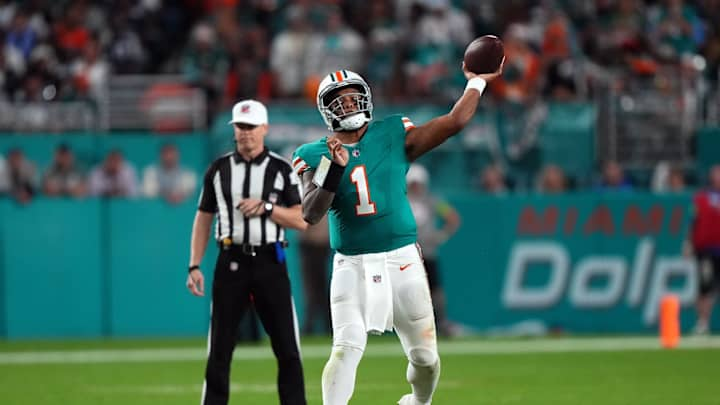Kelly: Are Dolphins really ready to propose to Tua?

If the Miami Dolphins woke up one morning and a young, elite quarterback fell into the franchise’s lap, and Tua Tagovailoa subsequently found himself on the trade or free agent market, what kind of interest and offers would he draw?
How many teams would be picking up the phone and calling General Manager Chris Grier about the former Alabama standout, whom the Dolphins tanked the 2019 season for?
If everyone could bid on Tagovailoa, a four-year starter with a 32-19 win-loss record, who has achieved a number of impressive statistical accomplishments - NFL’s top rated passer in 2022, and the 2023 passing yards leader - would there be a demand for his services?
That's the major question Grier and Miami's money people need to be asking themselves when considering how to handle contract proposals with Tagovailoa's camp.
Where would Tagovailoa stack up against Kirk Cousins, a 35-year-old who will likely be an unrestricted free agent this offseason, and Baker Mayfield, who just led the Tampa Bay Buccaneers to a playoff win, Russell Wilson or Jimmy Garoppolo, who are both expected to be on the trade block?
Negotiations are all about leverage, and understanding who holds it.
I’d argue that the Dolphins hold most of the leverage when it comes to this spring, and possible summer’s negotiations with Tagovailoa, whose camp is pushing for a long-term multi-year contract extension to replace his fifth-year option, which guarantees him $23.2 million for the 2024 season.
While a long-term deal for Tagovailoa would provide short-term benefits the Dolphins, which are roughly $75 million over the projected salary cap if they place the franchise tag on Christian Wilkins in the coming month, because it would lowering Tagovailoa’s cap hit for potentially the next two seasons, signing him to a mega contract that eats up 15-25 percent of the salary cap annually is a slippery slope.
But that’s what teams trying to lock up young, talented quarterbacks are paying these days to Joe Burrow, Justin Herbert, Jalen Hurts, and Lamar Jackson. Problem is, raising Tagovailoa’s tax bracket would force the Dolphins to become even more frugal when it comes to the team’s personnel, and that creates roster building challenges.
When the Dolphins’ rebuild began in 2019 the goal was to build a strong roster that featured many foundational pieces while the franchise had a inexpensive quarterback, which Tagovailoa was for his first four seasons while playing on a rookie deal that paid him $30.3 million over the first four years.
Now that Tagovailoa’s price tag is escalating, it will put more of a burden on the team’s personnel department to draft better, and add inexpensive free agents. With or without Tagovailoa signing a multi-year extension, the Dolphins are facing one of the most difficult financial offseasons in the franchise’s history. That creates challenges in itself.
But there’s also concern about making a long-term commitment to a quarterback who hasn’t proven he can win the big game, or deliver clutch performances when the season fate is in the balance.
Tagovailoa failed in many instances last year, and there’s concern about his durability based on his numerous injuries before the 2023 season, which was his first being fully healthy.
The thought process for his skeptics is that it would be more beneficial for the Dolphins to make Tagovailoa play on his fifth-year option, and then use the franchise tag to secure his services for the 2025 season. That’s a financial commitment of roughly $60 million over the next two seasons because the franchise tag for a quarterback is projected to be around 36-38 million in 2025.
That route would painful to manage from a salary cap standpoint because there’s no way to disburse the cap hit to other years, like a team would in a mega contract, but committing $60 million to a quarterback over two years is a lot more conservative than pledging to give him the $133.7 million Justin Herbert will receiver from the Los Angeles Chargers for the first three years of his $300 million contract, and the $146.5 million Joe Burrow will receive from the Cincinnati Bengals for the first three years of his seven-years, $275 million deal.
The Dolphins organization must ask themselves if they’re ready to propose to Tagovailoa and immediately walk down the aisle to say their “I do,” or if they’re willing to play hard by dragging out the engagement for two seasons?
My preference is Miami makes a fair, but conservative multi-year offer to Tagovailoa, something in the Kyler Murray range of five-year, $230.5 million, and if he balks at those figures they should let the process play out in 2024, having him play on the fifth-year option just like they did with Wilkins last season.
I’m also of the opinion that Cousins, Mayfield, Wilson and Garoppolo will all help set a more realistic quarterback pay structure this offseason, and the deals that they might land, and the interest that they could draw, could serve as a reality check for Tagovailoa and his camp.
So my advice is to not rush this proposal, and let the new parameters for the quarterback market steer the discussion.
Patience pays, especially when you hold the leverage.
